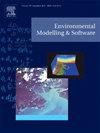What is the optimal digital elevation model grid size to best capture hillslope gullies and contour drains?
IF 4.8
2区 环境科学与生态学
Q1 COMPUTER SCIENCE, INTERDISCIPLINARY APPLICATIONS
引用次数: 0
Abstract
Aerial and ground-based survey routinely employs technology such as digital photogrammetry, Light Detecting and Ranging (LiDAR) and Terrestrial Laser Scanning (TLS). These systems produce huge data sets with varying accuracy and reliability. At present there are no guidelines for the grid size dimension needed to accurately and reliably represent common features such as rills, gullies and contour drains. Here, synthetic landscapes with a very high density of points (10,000 pt m−2) are created. Coordinate data capture error is also examined. Results demonstrate that for the reliable representation of a gully or contour drain, the DEM grid spacing needs to be at least 1/3 the width of the feature of interest. Typical coordinate errors inherent within the data do not significantly affect the definition of gullies or contour drains. The findings here provide a defensible guide for the coordinate density required to hydrologically and geomorphically represent a landscape surface.
什么是最佳的数字高程模型网格大小,以最好地捕捉山坡沟壑和等高线排水?
航空和地面测量通常采用数字摄影测量、光探测和测距(激光雷达)和地面激光扫描(TLS)等技术。这些系统产生的庞大数据集具有不同的准确性和可靠性。目前,对于准确可靠地表示常见特征(如沟壑、沟壑和等高线排水沟)所需的网格尺寸尺寸,还没有指导方针。在这里,创建了具有非常高密度点(10,000 pt m - 2)的合成景观。对坐标数据捕获误差进行了分析。结果表明,为了可靠地表示沟壑或等高线排水,DEM网格间距需要至少是感兴趣特征宽度的1/3。数据中固有的典型坐标误差不会显著影响沟壑或等高线排水沟的定义。这里的发现为水文和地貌学上代表景观表面所需的坐标密度提供了一个站得住脚的指导。
本文章由计算机程序翻译,如有差异,请以英文原文为准。
求助全文
约1分钟内获得全文
求助全文
来源期刊

Environmental Modelling & Software
工程技术-工程:环境
CiteScore
9.30
自引率
8.20%
发文量
241
审稿时长
60 days
期刊介绍:
Environmental Modelling & Software publishes contributions, in the form of research articles, reviews and short communications, on recent advances in environmental modelling and/or software. The aim is to improve our capacity to represent, understand, predict or manage the behaviour of environmental systems at all practical scales, and to communicate those improvements to a wide scientific and professional audience.
 求助内容:
求助内容: 应助结果提醒方式:
应助结果提醒方式:


